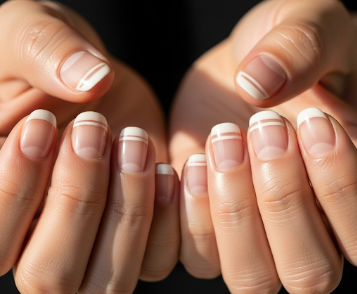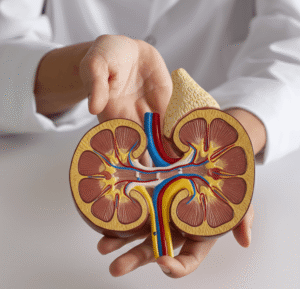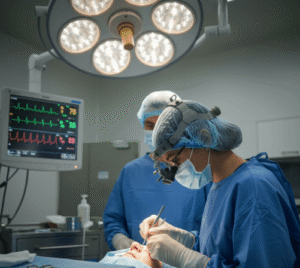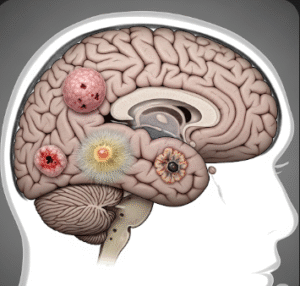Overview
Muehrcke lines are transverse white lines across the fingernails that run parallel to the lunula (the half-moon area at the nail base). These lines are non-palpable and do not move with nail growth, distinguishing them from other nail markings. They are usually a sign of low blood protein levels (hypoalbuminemia), malnutrition, or systemic illness rather than a primary nail disorder.
In Korea, dermatologists and internal medicine specialists can evaluate Muehrcke lines to diagnose underlying nutritional deficiencies, liver or kidney disorders, and other systemic conditions. Early detection allows timely treatment and prevents progression of associated health issues.
Key Facts
➤ Muehrcke lines appear as paired, transverse, pale white lines on fingernails.
➤ Unlike other nail markings, they do not move with nail growth.
➤ Commonly associated with low albumin levels, liver disease, kidney disease, or malnutrition.
➤ Can occur in both men and women of any age.
➤ In Korea, evaluation includes blood tests and systemic assessment for proper diagnosis.
What are Muehrcke Lines?
Muehrcke lines are visible bands in the nail bed, representing vascular changes beneath the nail caused by hypoalbuminemia or other systemic conditions. These lines are:
➔ Transverse – running horizontally across the nail.
➔ Paired – two lines may appear close together on each nail.
➔ Non-palpable – they do not rise or depress along the nail surface.
➔ Static – do not move as the nail grows, unlike Beau’s lines.
The appearance of these lines often indicates underlying systemic issues, making them an important clinical sign.
Symptoms Related to Muehrcke Lines
While Muehrcke lines themselves are asymptomatic, they may accompany symptoms of the underlying cause:
➤ Swelling or edema if hypoalbuminemia is present.
➤ Fatigue or weakness from malnutrition or liver/kidney disease.
➤ Yellowing of skin or eyes in liver dysfunction.
➤ Loss of appetite or digestive issues related to systemic illness.
➤ Occasional nail brittleness or changes in texture.
Causes / Possible Causes
Muehrcke lines are typically secondary indicators of systemic disorders:
Protein Deficiency
➤ Hypoalbuminemia due to malnutrition, protein-losing conditions, or severe illness.
Liver Disease
➤ Chronic liver conditions can reduce albumin production.
➤ Hepatitis or cirrhosis may contribute to systemic protein imbalance.
Kidney Disease
➤ Nephrotic syndrome or chronic kidney disease can cause albumin loss through urine, resulting in lines.
Other Contributing Factors
➤ Severe infections or burns causing protein depletion.
➤ Chemotherapy or other medications affecting nutritional status.
➤ Rare genetic or metabolic disorders affecting protein synthesis.
Risk Factors
➤ Individuals with chronic liver or kidney disease.
➤ Patients with malnutrition or eating disorders.
➤ Those recovering from major illness, surgery, or burns.
➤ People undergoing chemotherapy or prolonged medication therapy.
➤ Older adults with reduced protein intake.
Complications
Muehrcke lines themselves are not harmful, but they may indicate serious underlying conditions:
➤ Hypoalbuminemia complications – edema, fatigue, or impaired healing.
➤ Liver or kidney disease progression if untreated.
➤ Nutritional deficiencies affecting multiple organ systems.
➤ Delayed recognition may lead to worsening systemic illness.
When Should I See My Doctor?
Consult a healthcare professional if:
➤ Muehrcke lines appear suddenly or in multiple nails.
➤ Accompanied by fatigue, swelling, or other systemic symptoms.
➤ You have a history of liver, kidney, or nutritional disorders.
➤ Lines persist without obvious cause.
➤ You are unsure whether the lines indicate a serious health problem.
Early evaluation allows timely intervention for underlying conditions.
Care and Treatment
Treatment focuses on addressing the underlying cause:
Medical Management
➤ Correct hypoalbuminemia through dietary protein or supplementation.
➤ Treat liver or kidney disorders with appropriate medical interventions.
➤ Manage chronic illnesses contributing to protein loss.
Nutritional Support
➤ High-protein diet including eggs, lean meats, legumes, and dairy.
➤ Ensure adequate caloric intake to support overall nutrition.
➤ Consider vitamin and mineral supplementation if deficiencies are detected.
Monitoring
➤ Regular blood tests for albumin and other protein markers.
➤ Follow-up nail assessments to observe resolution of Muehrcke lines.
➤ Integrated care for chronic conditions affecting nutritional status and protein levels.
Treatment Options in Korea
Korean hospitals and clinics offer advanced diagnostic and therapeutic care for patients with Muehrcke lines:
Diagnostic Services
➤ Blood tests for albumin, total protein, liver, and kidney function.
➤ Imaging studies for liver and kidney assessment if indicated.
➤ Nutritional evaluation by dietitians.
Medical and Supportive Care
➤ Treatment of underlying liver or kidney disease.
➤ Protein supplementation or diet modification programs.
➤ Multidisciplinary care including nutritionists, internists, and dermatologists.
➤ Patient education on recognizing nail changes as systemic health indicators.
✅ In summary: Muehrcke lines are transverse white bands on the nails, usually reflecting low protein levels or systemic illness. While not dangerous themselves, they are an important clinical sign of hypoalbuminemia, liver or kidney disease, and nutritional deficiency. In Korea, patients can access comprehensive diagnostic evaluation, nutritional support, and medical care to address the underlying cause and promote overall health.













